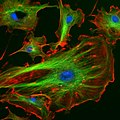Fluorescence microscope
Fluorescence microscope is a specific type of microscope that uses fluorescence and phosphorescence instead of, or in addition to, reflection and absorption to study properties of organic or inorganic substances.
History[edit]
The fluorescence microscope was first developed by August Köhler in 1904. It was further improved by Oskar Heimstädt, who published the first paper on fluorescence microscopy in 1911.
Principle[edit]
The basic task of the fluorescence microscope is to let excitation light radiate the specimen and then sort out the much weaker emitted light to make up the image. The main components of the microscope are the light source, the excitation filter, the dichroic mirror, and the emission filter.
Types of Fluorescence Microscopes[edit]
There are several types of fluorescence microscopes, including:
- Epifluorescence microscope: This is the most common type of fluorescence microscope. It uses a dichroic mirror to direct the excitation light onto the specimen and then collect the fluorescence light.
- Confocal microscope: This microscope uses a laser to excite a single plane of the specimen and then uses a pinhole to eliminate out-of-focus light.
- Two-photon excitation microscope: This microscope uses two photons of lower energy to excite the specimen. This allows for deeper penetration into the specimen and reduces photobleaching.
- Super-resolution microscope: This microscope surpasses the diffraction limit of light to provide higher resolution images.
Applications[edit]
Fluorescence microscopes are used in various fields, including biology, medicine, and material science. They are particularly useful in studying cellular structures and processes, protein interactions, and understanding the internal structure of materials.
See Also[edit]
References[edit]
<references />
|
|
|
-
Olympus BX61 fluorescence microscope
-
Fluorescence Filters 2008-09-28
-
Fluorescence Microscope Sample Herring Sperm SYBR Green
-
Depth Coded Phalloidin Stained Actin Filaments Cancer Cell
-
Dividing Cell Fluorescence
-
Fluorescent Cells
-
3D Dual Color Super Resolution Microscopy Cremer 2010
-
FISH 13 21
-
Yeast membrane proteins
Ad. Transform your life with W8MD's Budget GLP-1 injections from $75


W8MD offers a medical weight loss program to lose weight in Philadelphia. Our physician-supervised medical weight loss provides:
- Weight loss injections in NYC (generic and brand names):
- Zepbound / Mounjaro, Wegovy / Ozempic, Saxenda
- Most insurances accepted or discounted self-pay rates. We will obtain insurance prior authorizations if needed.
- Generic GLP1 weight loss injections from $75 for the starting dose.
- Also offer prescription weight loss medications including Phentermine, Qsymia, Diethylpropion, Contrave etc.
NYC weight loss doctor appointmentsNYC weight loss doctor appointments
Start your NYC weight loss journey today at our NYC medical weight loss and Philadelphia medical weight loss clinics.
- Call 718-946-5500 to lose weight in NYC or for medical weight loss in Philadelphia 215-676-2334.
- Tags:NYC medical weight loss, Philadelphia lose weight Zepbound NYC, Budget GLP1 weight loss injections, Wegovy Philadelphia, Wegovy NYC, Philadelphia medical weight loss, Brookly weight loss and Wegovy NYC
|
WikiMD's Wellness Encyclopedia |
| Let Food Be Thy Medicine Medicine Thy Food - Hippocrates |
Medical Disclaimer: WikiMD is not a substitute for professional medical advice. The information on WikiMD is provided as an information resource only, may be incorrect, outdated or misleading, and is not to be used or relied on for any diagnostic or treatment purposes. Please consult your health care provider before making any healthcare decisions or for guidance about a specific medical condition. WikiMD expressly disclaims responsibility, and shall have no liability, for any damages, loss, injury, or liability whatsoever suffered as a result of your reliance on the information contained in this site. By visiting this site you agree to the foregoing terms and conditions, which may from time to time be changed or supplemented by WikiMD. If you do not agree to the foregoing terms and conditions, you should not enter or use this site. See full disclaimer.
Credits:Most images are courtesy of Wikimedia commons, and templates, categories Wikipedia, licensed under CC BY SA or similar.
Translate this page: - East Asian
中文,
日本,
한국어,
South Asian
हिन्दी,
தமிழ்,
తెలుగు,
Urdu,
ಕನ್ನಡ,
Southeast Asian
Indonesian,
Vietnamese,
Thai,
မြန်မာဘာသာ,
বাংলা
European
español,
Deutsch,
français,
Greek,
português do Brasil,
polski,
română,
русский,
Nederlands,
norsk,
svenska,
suomi,
Italian
Middle Eastern & African
عربى,
Turkish,
Persian,
Hebrew,
Afrikaans,
isiZulu,
Kiswahili,
Other
Bulgarian,
Hungarian,
Czech,
Swedish,
മലയാളം,
मराठी,
ਪੰਜਾਬੀ,
ગુજરાતી,
Portuguese,
Ukrainian










